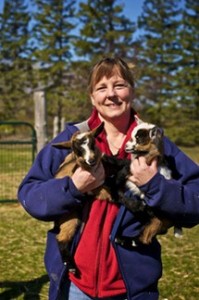Home Canning: An Overview
- Share
- Tweet
- Pin
- Share

Anna Knapp continues the family tradition of canning, which includes pickling eggs from her chickens. Photo by Len Villano.
The History
Historically people have faced the challenge of preserving food for winter, at first relying on salting and drying for meats, cellars for storing root vegetables, and pottery crocks for fruits and vegetables preserved with sugar and vinegar.
But at the turn of the 18th century Frenchman Nicolas Appert discovered the process of boiling in water hand-blown glass jars sealed with cork and wax. And in 1858 John Mason invented a factory-made jar with a screw-top zinc lid and rubber ring for a seal; in 1882 the glass jar with a wire bracket, glass lid and rubber ring was developed and home canning became popular. Early manufacturers Mason, Ball, Atlas, and Kerr have not only left their names on canning jars, but their imprints on food presevation.
At present home canners use a screw-top ring that holds a convex metal flat in place. A thin gasket of rubber affixed to the bottom of the flat creates the seal.
The process requires heating produce-filled jars to boiling in either a hot water bath in a metal canning kettle or trapping steam in a canner with a pressure gage, and letting them cool for a sterile vacuum seal. Generally the water bath method is used for high-acid produce such as tomatoes. Low-acid vegetables such as corn or green beans should be processed in a pressure cooker.
For jams, jellies, and pickles, some home canners place the heated product in hot jars and rely on cooling for a vacuum seal along with the preserving properties of sugar, salt and vinegar.
Early canners used the “open kettle” method, ladling hot tomatoes into heated jars and then securing the lids. A variation of this method was used for jams and jellies: topping the hot preserves with a layer of melted paraffin. Today’s home economists caution the use of either method.
Canning became a necessity for many people during the Depression and World Wars when they were driven by hard times to produce and preserve their own “Victory Garden” food.
A “back-to-earth” movement in the 1970s created a resurgence of interest in canning along with storing produce in chest freezers.
Canning in the 21st Century

Lynn Grasse learned how to can from her mother-in-law Grace, and now she and her husband Don also tend a herd of 20 dairy goats. Don said “It’s a choice for healthy living – to take the unknown out of what we eat.”
Home canning is alive and well today, even on the Door Peninsula. Northern Door sister-in-laws Iva and Lynn Grasse and Dorothy Tesnow, along with Iva’s daughter Anna Knapp, all preserve their own food, an activity no longer the sole province of women, as husbands sometimes help with the process. And occasionally men, including Jan Dickson of Sturgeon Bay, take charge.
While home canning information is available from the University of Wisconsin Extension, from online sources, and booklets provided with canning supplies, every canner consulted for this interview learned from mothers and grandmothers – a folk art that is passed along by oral tradition. Door County native Grace Grasse taught her daughter-in-laws how to can.
In the past home canners turned to food preservation to save money, but today health is a primary factor.
“We like to shop down in the basement,” Tesnow said. “I have a basement full of canned goods.” She and her husband raise vegetables in their garden, including heirloom tomatoes from seeds dating back to her mother’s time. She has been canning for 55 years because “I know what’s in the product,” and “I just like doing it.”
“Opening up the jar of fruit, tomatoes, or jams,” Iva Grasse said, “and knowing this is good quality food with no additives or preservatives,” is one of the reasons she has been canning for 40 years. And while she has help from her family, “I prefer to can by myself,” she said. “I’m in my glory preparing and then looking at all my filled jars sitting on the counter, and knowing I’m prepared for winter.”
Lynn Grasse has been canning for 15 years, in addition to tending a herd of 20 dairy goats. When she retires at the end of this school year, she and her husband will expand their gardens. “It’s a choice for healthy living,” Don Grasse said, “to take the unknown out of what we eat.”
Those who wish to eat locally and support sustainable agriculture often turn to home preservation. Knapp, who has been canning for 15 years, with the help of her husband maintains a Community Supported Agriculture garden plot. She learned canning by helping her mother and now participates in organic farming conferences along with classes at NWTC.
Dickson has been canning for 15 years with the help of his wife and children. While he uses jars from his mother and grandmother’s basements and learned by watching them, “an instructional booklet came along with the pressure cooker I bought,” he said.
“I’m lucky because I’m not afraid of [canning],” Knapp said. “Growing up around canning has made me a lot more confident about the process. It’s definitely not something to be afraid of, but some of the formal written guides made it sound like something to fear.”
Many home canners want their children to make a connection with nature, to realize that food does not originate in a supermarket. All of the home canners interviewed for this article involve their family in maintaining a garden and preserving food, activities that have been passed from one generation to the next.
And for all of them, including this writer, home canning is a labor of love.
“I can because I enjoy it,” Dickson said. The process is a celebration of the garden, preserving not only fruits and vegetables for winter eating, but maintaining a connection with a garden now dormant.
